Related Research Articles

Absalon was a Danish statesman and prelate of the Catholic Church who served as the bishop of Roskilde from 1158 to 1192 and archbishop of Lund from 1178 until his death. He was the foremost politician and church father of Denmark in the second half of the 12th century, and was the closest advisor of King Valdemar I of Denmark. He was a key figure in the Danish policies of territorial expansion in the Baltic Sea, Europeanization in close relationship with the Holy See, and reform in the relation between the Church and the public. He combined the ideals of Gregorian Reform with loyal support of a strong monarchical power.
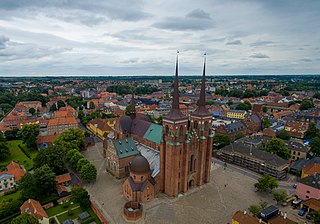
Roskilde Cathedral, in the city of Roskilde on the island of Zealand (Sjælland) in eastern Denmark, is a cathedral of the Lutheran Protestantism aka Church of Denmark.

Aarhus Cathedral is a cathedral in Aarhus, Denmark. It is the longest and tallest church in the country, at 93 m (305 ft) in length and 96 m (315 ft) in height.

The former Diocese of Aarhus was a Roman Catholic diocese in Denmark, founded in the 10th century and dissolved during the Protestant Reformation. The diocese included the counties of Aarhus and Randers, the islands of Samsø and Tunø, and, after 1396, part of the county of Viborg.
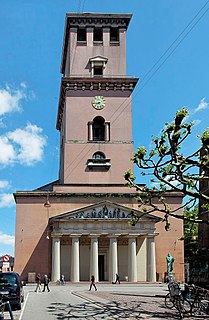
The Church of Our Lady is the cathedral of Copenhagen. It is situated on the Frue Plads public square in central Copenhagen, next to the historic main building of the University of Copenhagen.
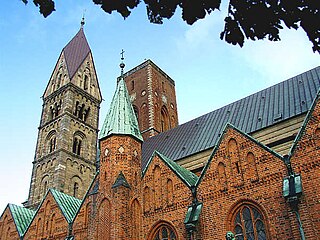
The former Diocese of Ribe was a Roman Catholic diocese in Southern Jutland, Denmark. The diocese was established in 948, and dissolved in 1536 during the Protestant Reformation. Within the newly established protestant Church of Denmark, the Diocese of Ribe effectively replaced its Roman Catholic precursor.
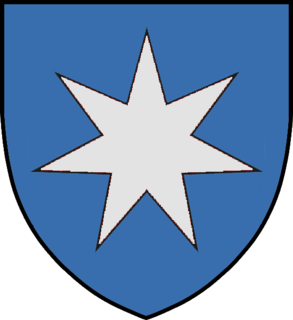
Hvide was a medieval Danish clan, and afterwards in early modern era a Danish noble surname of presumably one surviving branch of leaders of that clan. Before the 16th century it was not used as a surname. It signified the color white.

Sorø Abbey was the preeminent and wealthiest monastic house in all of Denmark during the Middle Ages. It was located in the town of Sorø in central Zealand.

The Diocese of Aarhus is one of 10 diocese in the Church of Denmark, with headquarters in the city of Aarhus. The diocese covers a large district of northeast Jutland and comprise 14 deaneries, of which four cover the extent of Aarhus city itself.
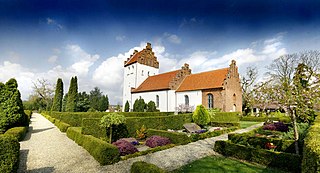
Skjalm Hvide, was the Earl of Zealand in Denmark in the end of the Viking Age (793–1066) and up to his death. Skjalm's father was Toke Trylle, whose father was Slag, based on Absalon, a medieval account scanned, translated and published by Google.

The former Diocese of Roskilde was a diocese within the Roman-Catholic Church which was established in Denmark some time before 1022. The diocese was dissolved with the Reformation of Denmark and replaced by the Protestant Diocese of Zealand in 1537.

Peder Krog was a Danish-born Norwegian Lutheran bishop.
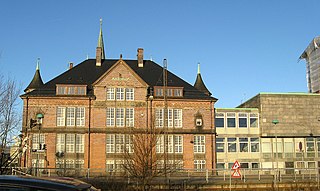
Aarhus Katedralskole is a cathedral school, an institution of secondary education, a Danish Gymnasium and a listed building in Aarhus, Denmark. The school is situated in the neighborhood Midtbyen, in the Latin Quarter, bounded by the streets Mejlgade, Kystvejen and Skolegyde. Aarhus Katedralskole offers the 3 year Matriculation examination (STX) programme with elective subjects in the natural sciences, social sciences and arts. The school is an independent self-owning institution financed by the Danish state with about 800 students divided across 30 classes.
Peder Vognsen was bishop of the Diocese of Aarhus from 1191 until his death in 1204. He belonged to the nobility as a member of the Hvide clan and was related to Archbishop Absalon. He used his extensive private means to found Aarhus Cathedral. He established several prebends for the cathedral which were authorized by Pope Celestine III in 1197 and confirmed by Pope Innocent III in 1198. From the deed of his donation to the cathedral in 1203, it can be seen he owned a large estate in Zealand including four churches. Peder Vognsen is entombed in Aarhus Cathedral. He is commemorated by a black marble slab in the chancel.
Svend I was the bishop of the Diocese of Aarhus between 1166 and 1191. Svend was a warrior and crusader who participated in numerous wars and raids with the Danish king. Contemporary historian Saxo Grammaticus mentions him as belonging to the inner circle of Valdemar I and Absalon. Svend may be best known for granting the Cistercian order large gifts of land which resulted in the founding of Øm Abbey by Mossø. It is known Svend was ordained bishop no later than 1166. Svend allowed Niels of Aarhus to be buried in Aarhus' St. Nicolai Cathedral after reports of miracles around the body and in connection with the burial.

Peder Jensen Lodehat was the bishop of the Diocese of Aarhus and a significant political figure in Denmark during the reign of queen Margrete I. Lodehat was originally from a minor noble family in Zealand but made a career in the Catholic Church as bishop of a total of 3 dioceses. He served on the Danish Riksråd and had a role in getting Margrethe I appointed queen. Lodehat also had a central role in the creation of the Kalmar Union and may have authored the founding documents. The surname Lodehat stems from a type of hat, Lodehat, featured on the family coat of arms but although the family has become known under this name they likely didn't use it in their own time.

Asser Rig – a.k.a. Asser Rig Skjalmsen Hvide – was a jarl and chieftain from Zealand, Denmark, a son of Skjalm Hvide and Signe Asbjørnsdatter.

Esbern Snare, also known as Esbern the Resolute, (1127–1204) was a høvding, or chieftain, royal chancellor and crusader. His family were members of the powerful Hvide clan. In 1192, during the Crusades and after the fall of Jerusalem, he led a small group of Danish soldiers to the Holy Land. Upon his return, he had the Church of Our Lady, Kalundborg built.
References
- ↑ "Vognsen, Skjalm" (in Danish). Danish Biographical Encyclopedia. Archived from the original on 11 October 2016. Retrieved 30 September 2016.